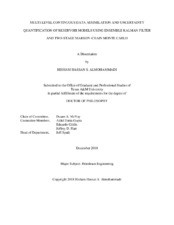| dc.description.abstract | It is common practice to base decisions related to reservoir development and operations on reservoir models. Keeping these models updated and adequately quantifying subsurface uncertainty is critical for generating reliable forecasts, making optimal decisions and assessing risks. This dissertation presents an approach for continuous data assimilation and uncertainty quantification of reservoir models using a two-level update method: (1) data assimilation using Ensemble Kalman Filter (EnKF); and (2) two-stage Markov-Chain Monte Carlo (MCMC). In comparison with previous combined EnKF-MCMC work, in this approach the likelihood function is calculated exactly rather than approximately to ensure robust sampling of the posterior distribution. Additionally, a filtering stage is introduced at the MCMC level to reduce the computational cost while maintaining the necessary assumptions for accurate sampling. Further, reduced parameterization methods are utilized to improve covariance estimation and reduce computational overhead.
In the first level, an ensemble of model parameters and their associated dynamic variables is updated by frequently assimilating measured well data using EnKF. In the second level, at a lower frequency, MCMC is used to sample the posterior distribution of model parameters conditioned to all well measurements available from the beginning of the first assimilation cycle to the current time. The information obtained at the first level is utilized in two ways. First, the posterior covariance estimated from the EnKF update is used to propose new states (containing both parameters and dynamic variables) in the
MCMC chain. Second, the likelihood function is approximated at the first stage of MCMC using Peaceman equations and the proposed state. Only when a state is accepted at the first stage is reservoir simulation used to evaluate the likelihood function at the second stage of MCMC.
This approach was tested using two synthetic reservoir simulation experiments: a 1-D, single-phase heterogeneous case and a 2-D, two-phase channelized characterization case. The results demonstrate an improvement in posterior sampling (more samples with higher values of posterior density) over EnKF and standard MCMC random-walk perturbation methods. Additionally, efficiency of the sampling process is enhanced (smaller burn-in size and higher acceptance ratios) at a reduced computational cost. Finally, production forecast distributions generated using this approach show continuous improvement (narrow down and shift toward the true solutions) as more data are assimilated.
The approach outlined in the paper can be used by operators to quantify uncertainty in production forecasts. Additionally, the multi-level approach provides operational advantage in that short-term and long-term operational decisions can be made based on high-frequency assimilation cycles and lower-frequency updates, respectively. | en |


